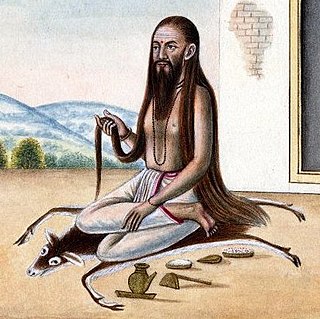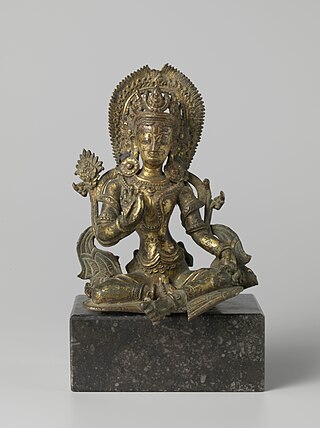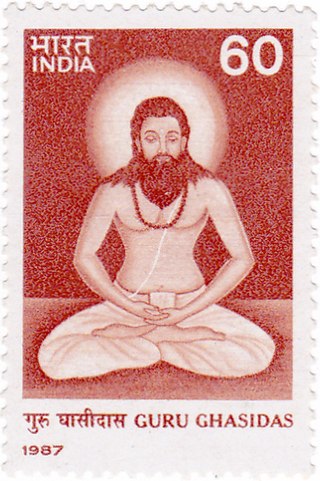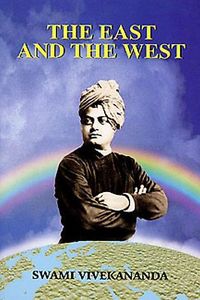Related Research Articles

Hinduism is an Indian religion or dharma, a religious and universal order or way of life by which followers abide. The word Hindu is an exonym, and while Hinduism has been called the oldest religion in the world, it has also been described as sanātana dharma, a modern usage, based on the belief that its origins lie beyond human history, as revealed in the Hindu texts. Another endonym for Hinduism is Vaidika dharma.

Indra is the king of the devas and Svarga in Hinduism. He is associated with the sky, lightning, weather, thunder, storms, rains, river flows, and war.

Brihaspati, is a Hindu god. In the ancient Vedic scriptures of Hinduism, Brihaspati is a deity associated with fire, and the word also refers to a god who counsels the devas and devis. In some later texts, the word refers to the largest planet of the solar system, Jupiter, and the deity is associated with the planet as a Navagraha.

Svaha, also referred to as Manyanti, is the Hindu goddess of sacrifices featured in the Vedas. She is the consort of Agni, and the daughter of either Daksha or Brihaspati, depending on the literary tradition. According to the Brahmavaivarta Purana, she is an aspect of Prakriti (nature), an element without which Agni cannot sustain.

Bharadvaja was one of the revered Vedic sages (maharishi) in Ancient India. He was a renowned scholar, economist, grammarian, physician and a follower of Maha Pashupata. He is one of the Saptarishis.

The historical Vedic religion, also known as Vedicism and Vedism, constituted the religious ideas and practices prevalent amongst the Indo-Aryan peoples of the northwest Indian subcontinent during the Vedic period. These ideas and practices are found in the Vedic texts, and some Vedic rituals are still practiced today. The Vedic religion is one of the major traditions which shaped Hinduism, though present-day Hinduism is significantly different from the historical Vedic religion.

Shaktism is one of the several major Hindu denominations wherein the metaphysical reality, or the godhead, is considered metaphorically to be a woman.
The Kalika Purana, also called the Kali Purana, Sati Purana or Kalika Tantra, is one of the eighteen minor Puranas (Upapurana) in the Shaktism tradition of Hinduism. The text was likely composed in Assam or Cooch Behar region of India and is attributed to the sage Markandeya. It exists in many versions, variously organized in 90 to 93 chapters. The surviving versions of the text are unusual in that they start abruptly and follow a format not found in either the major or minor Purana-genre mythical texts of Hinduism. Various types of animal sacrifices for devi are detailed in the Purana.

A Divya Desam or Vaishnava Divya Desam is one of the 108 Vishnu and Lakshmi temples that is mentioned in the works of the Alvars, the poet-saints of the Sri Vaishnava tradition.
Svayambhu is a Sanskrit word that means "self-born", "self-manifested", "self-existing", or "that that is created by its own accord". Various deities and entities featured in Hindu literature and tradition are regarded to be svayambhu, such as Brahman in the Upanishads, and the Trimurti of Brahma, Vishnu, and Shiva, and Manu in the Puranas.
In Hinduism, Rishabha is one of the twenty-four avatars of Vishnu in the Bhagavata Purana. Some scholars identify this avatar to be the same as the first tirthankara of Jainism, Rishabhanatha. Shaiva texts like the Linga Purana regard Rishabha to be among the 28 avatars of Shiva. Rishabha is also found in Vedic literature, where it means the "bull" and is an epithet for Rudra (Shiva).

Indrani, also known as Shachi, is the queen of the devas in Hinduism. Described as tantalisingly beautiful, proud and kind, she is the daughter of the asura Puloman and the consort of the king of the devas, Indra.
Iccha-shakti is a Sanskrit term translating to free will, desire, creative urge. It functions as the impulse towards manifestation within the principle of shakti, the concept of divine feminine energy. Along with kriya-shakti and jnana-shakti, iccha-shakti is described to constitute the three aspects of shakti in Hinduism, regarded to be responsible for the evolution of the universe in Tantra. In Shaivism, iccha-shakti represents one of the five shaktis of Shiva, alongside adi-shakti, parama-shakti, kriya-shakti, and jnana-shakti.

Devdutt Pattanaik is a mythologist and writer from Mumbai, India. He is also a speaker, illustrator and author, on Hindu sacred lore, legends, folklore, fables and parables. His work focuses largely on the areas of religion, mythology, and management. He has written books on the relevance of sacred stories, symbols and rituals in modern times; his more popular books include Myth = Mithya: A Handbook of Hindu MythologyJaya: An Illustrated Retelling of the Mahabharata and Sita: An Illustrated Retelling of the Ramayana and My Gita. Pattanaik has incorporated the Mahabharata and the Ramayana into human resource management.

Guru Ghasidas was the Guru of the Satnam Dharma, a Satnami Saint and a great Scholar from Chhattisgarh in the early 19th century. It was Guru Ghasidas who started preaching in a deep forested part of Chhattisgarh.

The practice of Hindu animal sacrifice is in recent times mostly associated with Shaktism, and in currents of folk Hinduism strongly rooted in local popular or tribal traditions. Animal sacrifices were part of the ancient Non-Vedic Era in India, and are mentioned in scriptures such as the Puranas. The Hindu scripture Brahma Vaivarta Purana forbids the Asvamedha Horse sacrifice in this Kali Yuga. However, the perception that animal sacrifice was only practiced in ancient Non-Vedic Era is opposed by instances like Ashvamedha and other rituals that are rooted in Vedas. Both the Itihasas and the Puranas like the Devi Bhagavata Purana and the Kalika Purana as well as the Saiva and Sakta Agamas prescribe animal sacrifices.
Praśastapāda was an ancient Indian philosopher. He wrote the Padārtha-dharma-saṅgraha and a commentary, titled Praśastapāda Bhāṣya, on the Vaisheshika Sutras of Kanada ; both texts are comprehensive books in physics. In these texts Prashastapada discusses the properties of motion. Ganganath Jha had translated Praśastapāda Bhāṣya which was published in 1916. Prashasta or Praśasta means praised or praiseworthy, lauded or laudable, commended or commendable or eulogized.

The East and the West or Prachya o Paschatya is a book written by Swami Vivekananda. In this book Swami Vivekananda made a comparative study of eastern and Western cultures.
Nimbarkacharya, also known as Nimbarka, Nimbaditya or Niyamananda, was a Hindu philosopher, theologian and the chief proponent of the theology of Dvaitadvaita (dvaita–advaita) or dualistic–non-dualistic sometimes known as svabhavika bhedabheda. He played a major role in spreading the worship of the divine couple Radha and Krishna, and founded Nimbarka Sampradaya, one of four main traditions of Hindu sect Vaishnavism.
Vedic learning started in Mithila with the expansion of Vedic and Brahmanic culture eastwards along the Ganges plain. Some sources consider this centre of Brahminical study to form an Ancient Mithila University. From the 12th/13th to 15th century CE it was an important centre of Nyaya Shastra and logical sciences.
References
- ↑ "Interview with Roshen Dalal – Author of The Puffin History of the World". Indian Moms Connect. Archived from the original on 20 December 2016. Retrieved 16 December 2016.
- ↑ "Roshen Dalal". WIC India Dehradun Literature Festival 2016. Archived from the original on 20 December 2016. Retrieved 16 December 2016.
- ↑ "Roshen Dalal". Penguin. Archived from the original on 20 December 2016. Retrieved 16 December 2016.
- ↑ "Roshen Dalal - Author details". Penguin India. Archived from the original on 29 August 2019. Retrieved 20 December 2017.
- ↑ Krithika, R. "A different kind of history book". The Hindu.